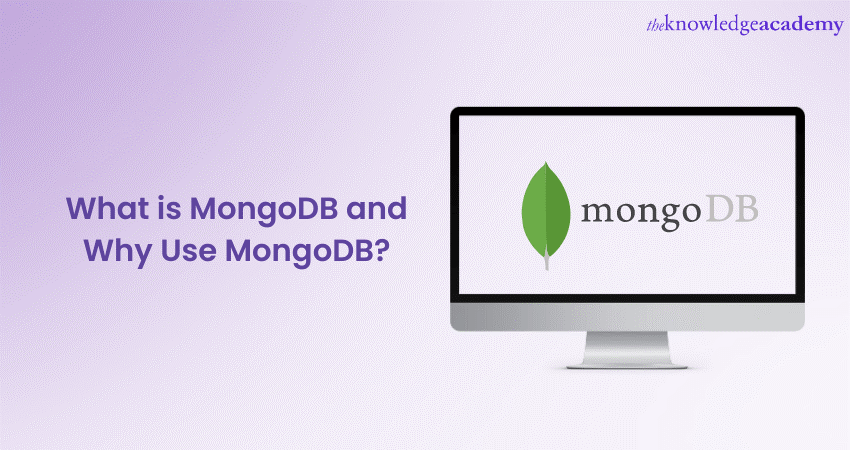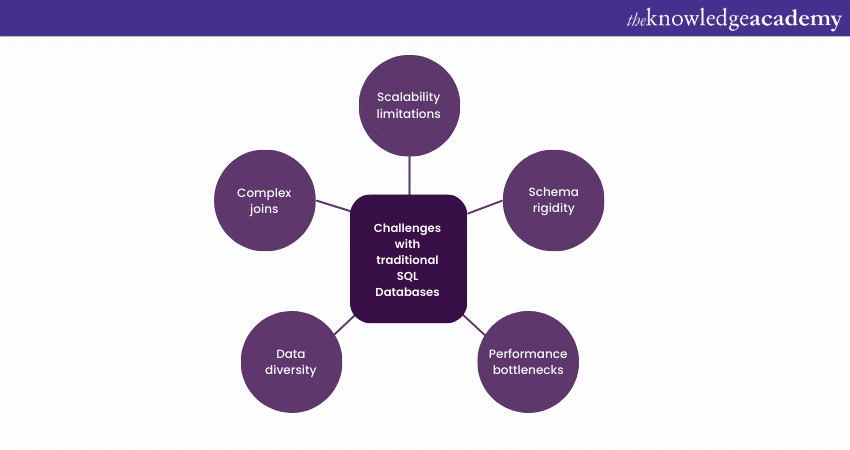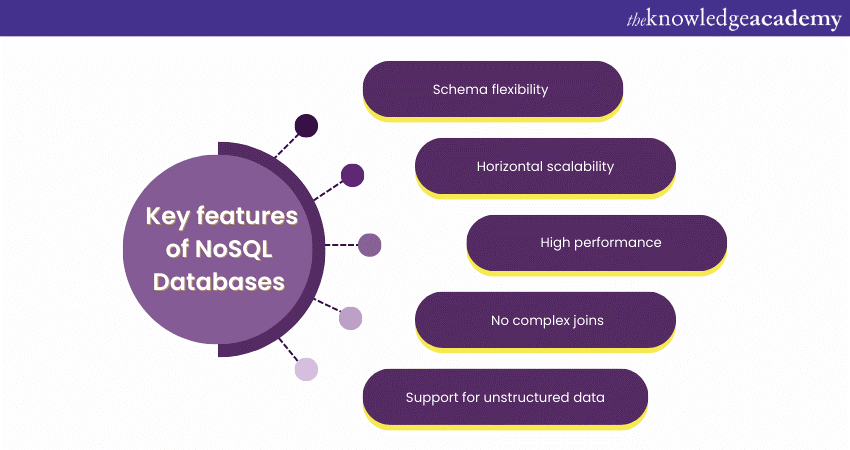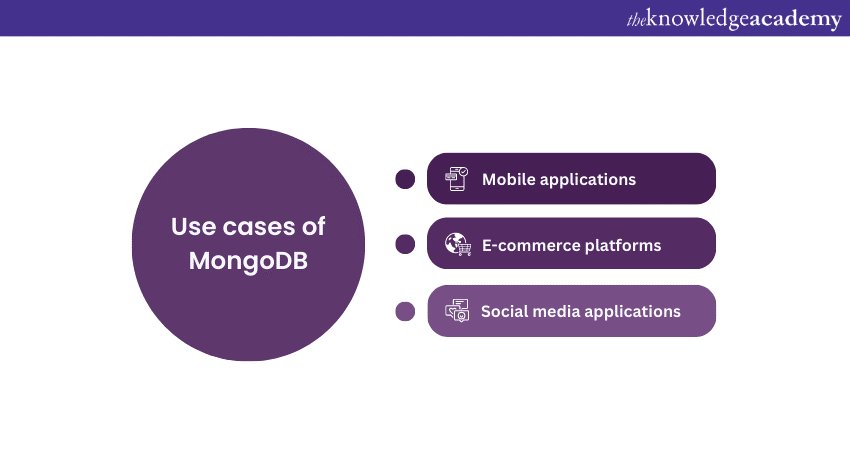We may not have the course you’re looking for. If you enquire or give us a call on +44 1344 203 999 and speak to our training experts, we may still be able to help with your training requirements.
Training Outcomes Within Your Budget!
We ensure quality, budget-alignment, and timely delivery by our expert instructors.

Managing large amounts of information efficiently is challenging for businesses and developers in today's data-driven world. This is where NoSQL Databases, such as MongoDB, come into play. MongoDB has gained tremendous popularity among developers, and the question "Why Use MongoDB?" has become increasingly prevalent.
As data becomes more complex, there is a growing need for flexible and scalable solutions beyond traditional Relational Databases. MongoDB is one such solution. This blog will answer "Why use MongoDB?", one of the most frequently utilised NoSQL Databases that is open source. Read more to find out.
Table of Contents
1) What is MongoDB?
2) The rise of NoSQL Databases
3) Top reasons to choose MongoDB
4) Use cases of MongoDB
5) Conclusion
What is MongoDB?
MongoDB is a prominent and versatile NoSQL Database that has revolutionised how data is stored and accessed in modern applications. Unlike traditional Relational Databases, MongoDB employs a document-oriented model, where data is stored in JSON-like documents with dynamic schemas.
These documents can vary in structure, allowing developers to effortlessly store and manage diverse data types within a single collection. MongoDB stands out for its exceptional capability to manage large quantities of data, which makes it the perfect choice for high-performance applications that require scaling.
Its distributed architecture enables horizontal scaling, allowing businesses to seamlessly expand their Databases across multiple servers or clusters as their data requirements grow.
Learn the fundamentals of MongoDB, including its key features and components, sign up for our MongoDB Developer Course now!
The rise of NoSQL Databases
Let us look at some of the factors that has contributed to the rise of NoSQL Databases:

Challenges with traditional SQL Databases

a) Schema rigidity: SQL Databases require a fixed schema, meaning the structure of tables and columns must be defined beforehand. Any changes to the schema can be cumbersome and time-consuming, especially for applications with evolving data requirements.
b) Scalability limitations: Scaling traditional SQL Databases vertically (adding more powerful hardware) has limits and can quickly become expensive. Horizontal scaling (distributing data across multiple servers) is often complex and may require significant application changes.
c) Complex joins: When working with large datasets, performing intricate joins across several tables can cause performance problems. Over time, as data grows, the join operations can become slower and impact application performance.
d) Performance bottlenecks: SQL Databases can encounter performance bottlenecks due to their reliance on rigid structures and complex query optimisation. High-concurrency scenarios may lead to contention and slower response times.
e) Data diversity: Storing diverse data types in a SQL Database can be challenging. As applications handle different data types, the schema may need to accommodate frequent changes, leading to a loss of consistency.
Introducing NoSQL Databases
a) Flexible data model: NoSQL Databases, including MongoDB, embrace a flexible data model, allowing developers to store data in various formats like key-value pairs, documents, column-family, or graphs. This adaptability enables developers to more efficiently accommodate changing data structures and evolving application needs.
b) Scalability and performance: NoSQL Databases are designed for horizontal scaling, distributing data across multiple servers or clusters to handle large volumes of data and high-concurrency workloads. This scalable architecture ensures seamless growth and improved performance without sacrificing speed.
c) Simplified schema design: Unlike traditional SQL Databases, NoSQL Databases do not rely on rigid schemas, allowing data to be added or modified without needing upfront schema definitions. This flexibility facilitates agile development and minimises the effort required for schema management.
d) Schemaless and semi-structured data: NoSQL Databases manage unstructured or semi-structured data, such as JSON, XML, or BSON, common in modern applications like social media channels, IoT applications, and Big Data Analytics.
e) High availability and fault tolerance: Several NoSQL Databases, such as MongoDB, offer integrated features for replicating data and automatically recovering from failures, guaranteeing the availability and dependability of data even when hardware malfunctions or network disruptions occur.
Want to develop an App or Website to your own specifications? Sign up for our App & Web Development Training now!
Key features of NoSQL Databases

a) Schema flexibility: NoSQL Databases offer dynamic schemas, allowing developers to store data without defining a fixed schema upfront. This flexibility simplifies the process of handling evolving data structures and makes it easier to adapt to changing application requirements.
b) Horizontal scalability: NoSQL Databases are designed for horizontal scaling, enabling data distribution across multiple nodes or servers. This approach ensures seamless scalability to handle growing datasets and high-concurrency workloads.
c) High performance: With optimised data storage and retrieval mechanisms, NoSQL Databases deliver excellent read and write operations’ performance, especially in large-scale data processing and real-time analytics scenarios.
d) No complex joins: NoSQL Databases typically avoid complex joins and emphasise denormalisation, reducing the need for time-consuming and resource-intensive operations when querying data from multiple collections.
e) Support for unstructured data: NoSQL Databases excel at handling unstructured or semi-structured data like JSON, XML, or key-value pairs, which are prevalent in modern applications such as social media channels and IoT-based applications.
Top reasons to choose MongoDB
Here are some of the points to support why MongoDB is popular among developers:
High scalability and performance
a) Horizontal scaling: MongoDB's architecture allows data to be distributed across multiple servers or clusters, enabling horizontal scaling. As data volumes grow, businesses can add more servers seamlessly, ensuring high scalability without compromising performance.
b) Automatic sharding: MongoDB employs automatic sharding, which intelligently distributes data across shards, based on predefined rules. This data partitioning strategy ensures balanced data distribution and efficient query execution, improving performance.
c) Indexes and query optimisation: MongoDB supports various index types, including compound, text, and geospatial indexes. Indexing enhances query performance and accelerates data retrieval, especially when dealing with large datasets.
d) In-memory processing: MongoDB's in-memory storage engine (e.g., WiredTiger) keeps data in memory, reducing disk I/O and significantly improving query response times for frequently accessed data.
e) Replication for high availability: MongoDB supports replica sets, maintaining multiple copies of data across different servers. If a primary server fails, one of the replicas automatically becomes the new primary, ensuring continuous availability and minimal downtime.
Flexible data model
a) Dynamic schema: MongoDB's document-oriented data model allows for a dynamic schema, meaning each document within a collection can have its unique set of fields and structures. This flexibility accommodates changes in data requirements without altering the entire database schema.
b) Easy data evolution: With MongoDB, developers can add or modify fields within documents on-the-fly, facilitating smooth data evolution as application needs evolve. This agility streamlines the development process, especially in fast-paced, agile environments.
c) Variety of data types: MongoDB supports a wide range of data types, including nested arrays, embedded documents, binary data (e.g., BSON), and geospatial data, making it well-suited for diverse data formats often encountered in modern applications.
d) Schema migration simplification: The absence of rigid schemas in MongoDB reduces the complexity associated with schema migration, as data structure changes can be done incrementally without disrupting existing data.
e) Polymorphism: MongoDB allows different documents in a collection to have different structures, enabling polymorphism. This enables developers to model complex relationships between data elements more intuitively.
Attain knowledge to run operations and display the results based on user input, sign up for our Javascript & JQuery Masterclass now!
No need for complex joins
a) Embedded documents: MongoDB's document-oriented data model allows for nested documents, enabling developers to store related data together within a single document. This eliminates the need for complex joins between multiple tables, as seen in Relational Databases.
b) Denormalisation: MongoDB encourages denormalisation, where redundant data is intentionally stored in multiple documents to reduce the need for joins. This approach improves query performance, especially for read-heavy applications.
c) Aggregation framework: MongoDB's powerful aggregation framework provides robust data processing capabilities, allowing developers to perform complex data transformations and calculations without the need for complex joins.
d) Real-time analytics: MongoDB's schema flexibility and aggregation pipeline support facilitate real-time analytics and reporting, enabling businesses to derive valuable insights from data with minimal query complexity.
e) Faster query execution: MongoDB queries can be executed faster without the overhead of complex joins, resulting in improved application responsiveness and reduced latency for end-users.
Distributed architecture
a) Multi-data centre replication: MongoDB's replica sets support multi-data centre replication, allowing data to be copied across geographically dispersed locations, ensuring data redundancy and continuity in the event of a data centre outage.
b) Data partitioning: By sharding data across multiple nodes, MongoDB enables efficient data partitioning, ensuring that each shard contains a manageable subset of data for efficient query processing.
c) Automatic failover: MongoDB's distributed architecture includes automated failover, automatically promoting a replica to the primary role if the primary node fails, ensuring continuous availability and data integrity.
d) Load balancing: MongoDB automatically distributes read and write operations across replica set members, optimising resource utilisation and load balancing, thereby enhancing overall system performance.
e) Geographical distribution: MongoDB supports data replication across multiple data centres, enabling businesses to create geographically distributed Databases. This ensures data availability, disaster recovery, and reduced latency for users in different regions.
JSON-like documents
a) Native data format: MongoDB stores data in BSON (Binary JSON), a binary representation of JSON, which is a widely used human-readable data format. This native support for JSON-like documents makes it easy for developers to work with data and integrate MongoDB into their applications seamlessly.
b) Denormalisation support: With JSON-like documents, developers can embed related data directly into a document, reducing the need for complex joins and simplifying query logic, resulting in improved performance.
c) Simple API integration: JSON is a widely used format for APIs. MongoDB's support for JSON-like documents makes it an excellent choice for applications that interact with various web services and APIs.
d) Rich data structure: JSON-like documents support nested arrays and objects, making it easy to represent complex relationships and hierarchical data structures.
e) Integration with JavaScript: As MongoDB is often used with Node.js, the native JSON support further strengthens the integration with JavaScript-based applications, fostering a seamless development experience.
Learn the basics of Mobile Apps, sign up for our Mobile App Development Training now!
Use cases of MongoDB
Let us briefly go over some use cases of MongoDB:

Mobile applications
a) Social and collaboration apps: MongoDB's document-based storage is well-suited for social networking and collaboration apps, as it allows for nested data structures, simplifying the representation of relationships and interactions.
b ) In-app messaging: MongoDB's ability to store and retrieve complex messages with attachments efficiently makes it an excellent choice for apps featuring in-app messaging and communication functionalities.
c) User profiles and preferences: Mobile apps can use MongoDB to store user profiles and preferences, ensuring a personalised experience based on individual settings and preferences.
E-commerce platforms
a) Product catalog management: MongoDB's flexible schema allows e-commerce platforms to efficiently manage diverse product data, including varying attributes, categories, and specifications, providing a seamless shopping experience for customers.
b) Real-time inventory tracking: MongoDB's real-time data processing capabilities enable e-commerce platforms to track inventory levels accurately, ensuring that product availability is up-to-date, while reducing the risk of overselling.
c) Order management: MongoDB's high write performance and horizontal scaling make it ideal for handling real-time order data, ensuring smooth order processing and accurate customer order tracking.
Social media applications
a) Hashtag and trend analysis: MongoDB's efficient querying capabilities support hashtag-based searches and trend analysis, helping social media platforms identify popular topics and monitor user sentiment.
b) Social media monitoring: MongoDB's horizontal scaling and sharding capabilities make it suitable for managing vast amounts of social media data, facilitating real-time monitoring of social media activity and sentiment analysis.
c) Location-based services: Social media applications can leverage MongoDB's geospatial indexing to enable location-based features, such as check-ins, location tagging, and location-based content discovery.
Conclusion
MongoDB is a powerful solution for modern applications with its versatile features and robust capabilities. Its flexible data model, high scalability, and real-time performance make it the optimal choice for a wide range of use cases while answering the question, "Why use MongoDB?"







 Top Rated Course
Top Rated Course




 If you wish to make any changes to your course, please
If you wish to make any changes to your course, please


